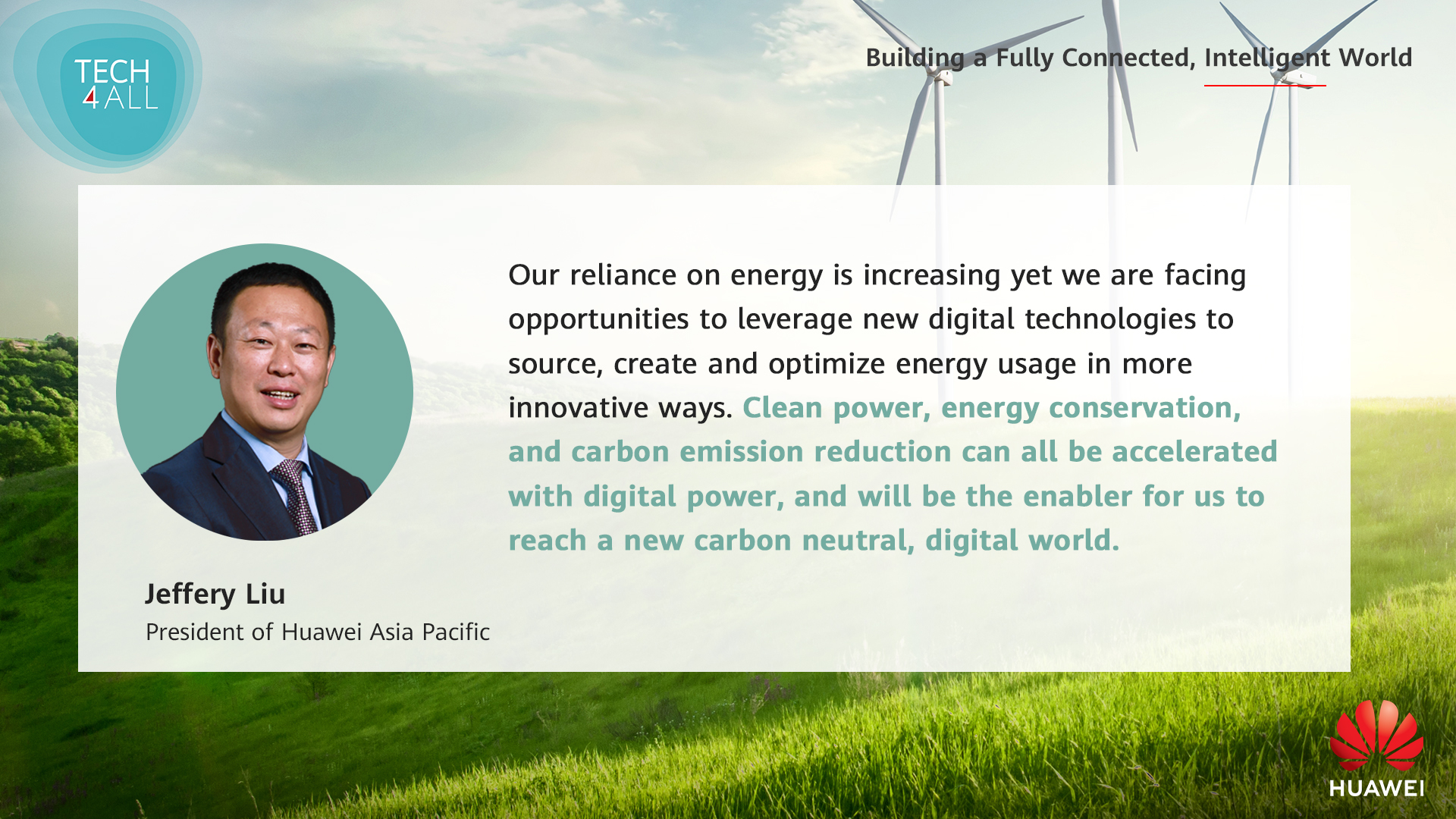By Jeffery Liu, President of Huawei Asia Pacific
Our footprint on the world is unmistakable, and our impact on climate change requires immediate action to ensure a green, sustainable planet for future generations. The good news is that as our use of the earth’s resources has changed, so has our ability to manage them in innovative ways. New ICT brings with it the tools to connect, sense and process data in intelligent ways and make better informed decisions about the world around us.

New technologies are giving rise to more efficient storage of energy and manufacturing of electronics using materials in greater abundance, and new energy sources are becoming more effective in replacing our reliance on fossil fuels. With effective policies and greater public awareness, we can reach carbon neutrality through a combination of reforestation, clean power, energy conservation, and carbon emission reduction.
Reforestation is an important step towards achieving carbon neutrality, but the reality is that it achieves limited results to address immediate concerns. Research results show that it takes approximately 15 40-year old trees to absorb the carbon dioxide produced by a single average-weight human male. As a result, clean power, energy conservation, and carbon emission reduction is paramount, and digital technology will play an important role in all the three areas.
Renewable energy has already begun to replace traditional fossil fuels with solar photovoltaic (PV) generating as much as 25% of total electricity needed by 2050. In total, electricity from renewable sources will overtake petroleum by 2050, accounting for 45% of the energy mix.
While solar PV is facing unprecedented opportunities for growth, it is not without challenges.
Access to the power generated by solar PV will need to be ready on demand, the same way conventional energy sources are, to avoid straining power grids.
As such, advances in storage are essential to prepare solar PV to be a primary energy source for power grids. With integrated digital and power electronic technologies in PV and energy storage systems, Huawei has developed a smart modular design, which refines energy storage system management. Innovative smart energy storage solutions could increase the discharge capacity and at the same time reduce costs.
In Sarawak, one of the largest states in Malaysia with around 2.8 million population, Huawei's intelligent micro-grid solution is supporting sustainable power supply for local villagers. As part of The Rural Electrification Masterplan, this advanced solution contains an energy storage system and supports diesel generator access, which helps to provide 24/7 electricity supply to the village, and even for up to three days when there is insufficient sunlight.
In addition to replacing traditional power generation, smart PV is creating new opportunities.
Rural communities not only lack critical communication services, but often reliable power. Combined with mobile base station solutions, smart PV products are powering connectivity to millions of new Internet users and helping connect the unconnected.
Digital power technologies are accelerating our path towards carbon neutrality by enabling the ICT industry to use energy more effectively and efficiently. Huawei is committed to promoting green ICT solutions, through which we aim to drive industries to conserve energy, reduce emissions, and build a low-carbon society that saves resources.
For telecom operators, Huawei's solution features a simplified system architecture and natural cooling, which improves energy efficiency to 97% compared to 60% in traditional telecom sites.
For network edge equipment in the wireless access scenario, especially 5G equipment, we have made innovations in chipset design techniques and algorithms, filters, hardware materials, and heat dissipation techniques, already helping to reduce the energy consumption of 5G equipment by 15%. The energy consumption per bit of 5G is just 4% that of 4G.
As of June 30, 2021, our digital power solutions had significantly contributed to energy conservation and carbon emission reduction efforts by generating 403.4 billion kWh of clean power and cutting CO2 emissions by 200 million tons globally, equivalent to planting 270 million trees.
While technology has already started to play a role in achieving carbon neutrality, there is still work to be done to accelerate efforts through favorable policy.
For smart PV, governments and industry partners can encourage market-based energy trading and pilot virtual power plant business models to promote energy conservation and balance electricity consumption.
At a residential level, and perhaps one of the best ways to get public support, low-carbon living for residents should be encouraged with initial subsidies to increase resident’s willingness to invest in solar energy, which has been proved effective in some countries.
As mobile connectivity grows and evolves, clearer roadmaps for communications industry emissions reduction based on energy conservation and emission reduction objectives should be established, with evaluation criteria for carbon emission indicators of communications network infrastructure. As an industry, we are in a position to help guide planning of electricity coverage policies for people's livelihood, enable solar power to be more readily available, and increase investment in electricity supply facilities for remote and island residents.
Our reliance on energy is increasing yet we are facing a new opportunity to leverage new ICT and digital technologies to source, create and optimize energy usage in more innovative and efficient ways. Clean power, energy conservation, and carbon emission reduction can all be accelerated with digital power, and will be the enabler for us to reach a new carbon neutral, digital world.





